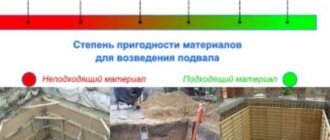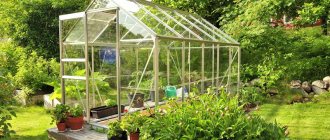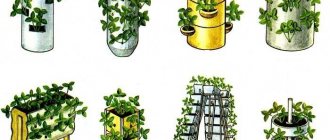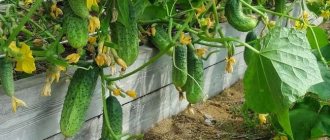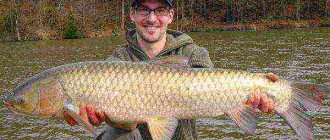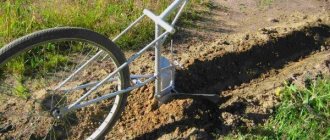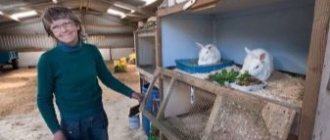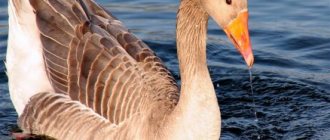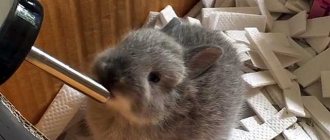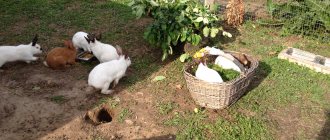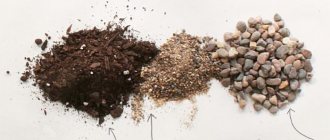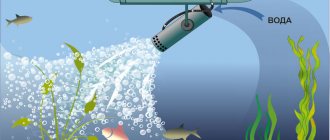Plastic mesh
Mesh made of plastic materials is used quite often. The advantages of such a device are wear resistance and strength, capable of withstanding even significant loads from the weight of ripe cucumbers. So you can rest assured that the structure will not break.
The most popular of all is a mesh with cells from 10 to 15 cm. You can purchase them ready-made or build them yourself using empty plastic bottles.
Advantages and disadvantages of artificial mesh
Using a net when cultivating cucumbers has its advantages and disadvantages.
The advantages of the mesh include:
- Space saving. This is relevant in small areas and in greenhouses, when it is necessary to obtain a harvest from several varieties of vegetable crops in a limited area.
- Support for growth. During development, cucumbers have the ability to cling to the net with their antennae, which ensures their normal growth.
- Prevention of diseases of cucumbers. Fungal diseases often develop in humid environments, when the roots and aerial parts of cucumbers are not accessible to air. The mesh ensures that the cucumbers are positioned in such a way that aeration is at a high level.
- Convenience during agricultural activities. Organized beds are accessible from any side. This makes it easier and more efficient when fertilizing, loosening, watering and other work. The fruits are in plain sight, which guarantees their high-quality harvest and prevents over-ripening.
- Optimal development conditions. The plants do not touch each other, and the vines do not intertwine. There is enough sunlight for every leaf and fruit. There is no competition, which causes stress in the vegetable crop and leads to the appearance of bitterness in cucumbers, reducing the overall yield.
- No mechanical damage to fruits and plants. Vertical cultivation ensures the ripening of whole fruits, protecting them from spoilage by animals, insects or accidental damage during harvest. In addition, cucumbers are protected from contamination, since they do not have contact with the ground.
- Aesthetics of the beds. Beautiful, well-kept garden beds are pleasing to the eye and arouse the envy of neighbors.
The use of cucumber mesh has no obvious disadvantages. Rather, these are small nuances:
- Requires more frequent watering of the area.
- Vertical placement of cucumbers shades the surrounding area. This problem can be solved by planting shade-loving garden crops at the base of the bed.
After the end of the season and harvesting of cucumbers, it is recommended to roll the cucumber net and put it away for storage until spring. This will limit the impact of the external environment on the material of the product and preserve its performance properties.
Trellis nets
Such grids are more popular and in demand. For growing cucumbers in open ground, using a trellis is more practical and sustainable.
The additional supports used will support any amount of harvest. In this case, the gratings can be installed vertical, inclined, A-shaped or arched.
Types of products
Before tying cucumbers in open ground, you need to familiarize yourself with the main varieties of such structures. There are several types of nets for gartering cucumbers in the greenhouse and outdoors.
Plastic
Plastic cucumber mesh is quite often used when growing cucumbers. You can buy it in a store or try to make it from plastic bottles with your own hands.
Structures made from such material have their own advantages that distinguish them from other meshes. Such products can handle heavy loads without any problems. They also have a high level of wear. Therefore, you should not worry that when attaching cucumbers to such a product, it will quickly break.
To tie cucumbers in open ground or greenhouses, it is better to use models with cell widths greater than 10-15 cm.
Trellis
Trellis mesh is used much more often than plastic mesh. A trellis is better suited for growing cucumber bushes. This product is more reliable and functional, since it is attached to several additional supports. They are installed so that with the help of a trellis net for cucumbers it is possible to grow bushes even with very large fruits. When growing cucumbers, various trellises can be used. Most often the following types are used for this:
- Vertical. When using such meshes, the frame can be made of wood, pipes or metal profiles. This design is very simple, since it consists of only two pillars and a mesh between them.
- Inclined. This trellis has a more complex design. Its frame is installed on the site not at a right angle, but at a slight slope. A small pole is attached to it, which makes the entire structure more reliable. The angle of inclination of such grid models can be different. For example, if low-growing cucumbers are grown in a garden bed, then the frame should be tilted by about 35-40 degrees.
- A-shaped. This net for cucumbers in a greenhouse is used by many vegetable growers. It got its name because its frame closely resembles the letter “A”. Two posts are installed on both sides of the beds and rest on each other.
- Arched. Such a trellis is rarely used, since installing a mesh in the form of an arch is quite difficult.
See also
Description of the cucumber variety Eliza, features of cultivation and careRead
Sloping structures
The construction of inclined trellises is more complicated than the previous ones. It consists in the fact that the frame with the mesh is mounted at an angle, and not in a straight line.
In this case, the value of the angle depends on the variety of cucumbers grown in a given place. So, for low-growing varieties, 35 or 40 degrees is enough. For reliability, a pole is attached to the frame.
How to assemble the structure and tie the lashes correctly
How to install depends on the material you choose. The most important thing is to make strong side supports. They should be placed at the edges and made thicker than the intermediate ones. The latter are placed at a distance of up to 10 meters.
If the weight of the fruit exceeds 150 grams, it makes sense to place columns more often. It is recommended to tie the cucumbers to the net as correctly as possible, because during ripening the stems can no longer be attached in any other way.
A-shaped trellises
Externally, the structure of the structure is similar to the letter A, hence the name. When growing cucumbers on a grid in a greenhouse or open ground, many gardeners use this particular design. Install two pillars on different sides of the bed, which support each other.
How to make a mesh with your own hands?
Trellis structures can be made of any shape (tent, arch, lattice, etc.), using available materials from:
- wood;
- mesh netting and other similar materials;
- plastic.
If the supporting devices for cucumbers have a permanent location, then there is a need to annually replace the soil under them so that the plants have enough nutrition for growth and vegetation.
A simple design option for vertical growing is to stretch thin wire with a diameter of up to 2 mm in several horizontal rows between support posts.
You can improve the design by placing a beam between the supports and lowering the required number of vertical cords from it. Each of them must be positioned in a tense manner. To do this, tie a metal hook to the ends and push it into the ground. It is possible to fix the cord on a rail located along the bed parallel to the upper support.
Easy to use design made from bicycle rims. Attach one rim to the support post through the middle hole above the ground, and the second rim to the end of the support. Thread the twine through the needle holes and pull it taut.
If you show your imagination, you can come up with many more devices that ensure high-quality vertical and horizontal cultivation of cucumbers in various areas, including when growing cucumbers in a greenhouse.
How to weave a network yourself is shown in the video below:
The process of gartering cucumbers
Cucumbers will not be able to attach to the net on their own, so they need a little help with this. How to tie cucumbers on a net? The answer is simple. During the period when the cucumber bushes have grown to 15-20 cm in height, it is necessary to fix their tops on the lowest row of the grid, located exactly at this height.
As the plant grows, regularly tie the regrown shoots to the net to give the bush a certain shape.
For greater reliability, garter in a checkerboard pattern to slightly slow down the growth of the bush in height and provoke its growth in width.
Basic recommendations for making mesh
Before growing cucumbers on a net, you need to understand the basic recommendations for making nets for outdoor or greenhouse growing of vegetables.
Making such gratings yourself is quite labor-intensive work. The duration of work depends on many different factors. This may be affected by the materials that will be used in the work process and the size of the area for growing bushes. When making supports to which cucumbers can be attached, the following recommendations should be taken into account:
- If you create a mesh for cucumbers with your own hands and stretch it over beds less than ten meters long, then for a good and more reliable fastening it is better to use three metal or wooden posts. When installing in a greenhouse, supports no more than 2-3 meters are used.
- To secure the mesh fabric, you will have to install several slats about five meters long.
- To create a garden net, you must use very strong wire.
Cucumber care
You will get an excellent harvest only if you provide proper care for the cucumbers on the net. The basis of proper care is considered to be timely watering with warm water. If you use cold water, the roots may begin to rot.
The best time for watering is a cloudy day or evening. In summer, during a particularly hot period, about 3 liters of water are needed to water one bush.
The resulting crust on the surface of the earth, after watering, needs to be loosened so that the soil is fully enriched with oxygen and the liquid is absorbed faster.
First feeding of cucumbers: tips for choosing fertilizers and methods of their use. Step-by-step instructions for beginners
Self-pollinating varieties of cucumbers are the best varieties for greenhouses and open ground. Features of planting and growing self-pollinating cucumbers (90 photos)
Cold pickling of cucumbers: step-by-step description of the traditional cooking recipe, subtleties and tricks of canning cucumbers (125 photos + video instructions)
To ensure the formation of fruits, bushiness of the plant and increase fruiting, it is recommended to carry out pinching.
To do this, you should pinch off the top of the main stem after the fourth leaf on the bush has formed. Only early varieties of cucumbers should not be pinched; the female inflorescences are located on the main stem.
Step-by-step instructions for installing and assembling the mesh
Installation of a trellis structure does not require special knowledge. Even a beginner can cope with such work.
To ensure that cucumbers receive enough sunlight and develop evenly, install the agricultural net from the east to the west.
To assemble the mesh you will need:
- Support pillars. They can be wooden, metal, plastic, PVC pipes are suitable. Dig two pillars about 2 m long into the ground to a depth of 35-45 cm along the edges of the bed. Compact the soil around the supports with special care. If necessary, do not neglect the installation of additional pillars. Keep in mind that they will bear the brunt of the weight of the cucumbers and natural phenomena. Only a strong structure can withstand wind squalls. Keep the distance between the supports the same.
- Cucumber mesh. Choose it at your own discretion. It is advisable to purchase one with cells with a side of at least 10 cm.
- Wooden slats. It is installed along the supports, between them to increase the reliability and stability of the structure. The mesh is attached to the slats when stretched.
- Fasteners The metal mesh is attached to the rail using pre-welded corners with holes and fixed with self-tapping screws or self-tapping screws. To simplify the work, use a screwdriver. And to tie the trellis net to the supports, you will need twine, rope or plastic clamps used for cables.
To assemble the structure, follow the algorithm:
- Mark the bed and dig or drive 2 supports along its edges.
- Lay the mesh on the surface of the ground. Carefully string it onto the rail with movements reminiscent of gathering a curtain onto a curtain with a ring fastening.
- Screw the rail with self-tapping screws to the support posts on both sides. The result will be a design in the shape of the letter “P”.
- Stretch the mesh from top to bottom, securing it to the support posts with a rope. It should be pulled tight enough for ease and practicality of use.
- If necessary, secure the mesh to the ground using metal hooks, deepening them into the ground.
Upon completion of the work, the structure is completely ready for use.
Watch the video where an experienced gardener demonstrates how easy it is to stretch a cucumber net yourself:
Agricultural technology of cucumbers on a trellis
Agricultural technology for cucumbers on a trellis includes:
- correct choice of predecessors (crop rotation);
- soil preparation;
- sowing or planting;
- fertilization;
- garter to the trellis;
- plant formation;
- harvesting.
Predecessors
It is best to plant cucumbers in areas where they previously grew:
- early vegetables;
- tomatoes;
- cabbage;
- onion.
Slightly less suitable are:
- legumes (except beans);
- early potatoes;
- root vegetables (beets).
Photo gallery: suitable predecessors for cucumbers
Legumes are considered suitable predecessors of cucumbers, not counting beans.
Cucumbers will grow well where cabbage was before
Early potatoes are also suitable as a predecessor to cucumbers
It is better to plant cucumbers in the place where onions used to be
A root vegetable like beets is a little less suitable as a predecessor to cucumbers.
Tomatoes are considered suitable predecessors for cucumbers
Soil preparation
It is advisable to place the beds for planting cucumbers on a trellis from east to west so that the plants are well lit throughout the day. The width of the beds for single-row planting should be 40–45 cm, and for double-row planting - 70–80 cm. The soil for cucumbers is prepared in the fall:
- dig up the selected area;
- per 1 m² add 5–6 kg of manure, 30 g of superphosphate, 200 g of ash or dolomite flour;
- The soil is leveled so that water does not accumulate in one place.
In the spring, before sowing seeds or planting seedlings, the ground is disinfected with a hot dark solution of potassium permanganate. If cucumbers are grown from seeds, the trellis can be installed before sowing or later, when the first pair of true leaves have formed on the sprouts. If the seedling method is used, the trellis is installed before planting the plants.
Planting scheme
Seeds or seedlings are placed on the bed in 1 or 2 rows along the trellis. Planting pattern:
- between plants in a row - 15–20 cm;
- between rows - 15–20 cm;
- between parallel trellises - 80–100 cm.
The scheme for planting cucumbers on trellises assumes a distance between bushes and rows of 15–20 cm
Feeding
During the season, 4 feedings of cucumbers are carried out:
- with the seedling method - 2 weeks after planting in the garden, and with sowing - after the formation of the 5th leaf on the seedlings;
- when the first flowers appear;
- during the ripening of the bulk of the fruit;
- 20 days after the third feeding - to extend the growing season.
Depending on the fertility of the soil and his preferences, each gardener selects the composition of fertilizers he needs.
All solutions of organic and mineral fertilizers for root feeding are used in a volume of 1/2–1 liter for each plant.
To prolong fruiting, cucumbers are fertilized with organic matter - 1 part of the herb infusion is diluted with 5 parts of water, using 1/2–1 liter for each plant, or in the same volume with a solution of one of the minerals in water (10 liters):
- 25–30 g baking soda;
- 200 g of ash.
Foliar feeding is carried out with a urea solution (15 g per 10 l of water).
If the land on the site is fertile, cucumbers are fertilized only 2 times: 2 weeks after planting and to prolong the growing season during the fruiting period.
Table: options for organic fertilizers for the first feeding
| Name | Concentration (kg/l water) |
| Fresh bird droppings | 1/15 |
| Slurry | 1/8 |
| Cow or horse manure | 1/6 |
| Green herb infusion | 1/5 |
Preparing fertilizers from bird droppings and manure consists of stirring these substances in water; infusion of the herb requires little more effort:
- Fill a container (preferably non-metallic) with mowed grass, weeded weeds or hay.
- Compact.
- To fill with water.
- Press down the grass with a weight so that it does not float.
- Cover with a lid or cloth.
- Leave to ferment for 1-2 weeks. During fermentation, an unpleasant odor is released, which will disappear when the process is completed.
- Then dilute 2 liters of herbal infusion in 10 liters of water.
Video: preparing herbal infusion
Table: options for mineral fertilizers
| Name of fertilizers /variants | Urea (g) | Superphosphate (g) | Ammonium nitrate (g) | Potassium salt (g) | Ammophos (g) |
| I per 10 liters of water | 30 | 60 | |||
| II for 10 liters of water | 10 | 10 | 10 | ||
| III spread over 1 m² and cover with loosening | 5 |
Table: options for the second fertilizing with mineral fertilizers
| Name of fertilizers /variants | Potassium nitrate (g) | Superphosphate (g) | Ammonium nitrate (g) | Ash (g) |
| I per 10 liters of water | 20 | 40 | 30 | |
| II for 10 liters of water | 200 | |||
| III spread over 1 m² and cover with loosening | 30 | 200 |
The second time you can feed cucumbers either at the root or by spraying.
Table: options for foliar feeding
| Name of fertilizers /variants | Superphosphate (g) | Potassium permanganate (g) | Boric acid (g) | Sugar to attract pollinating insects (g) |
| I per 10 liters of water | 35 | |||
| II per 1 liter of water | 0,5 | 7 | ||
| III 1 l | 2 | 100 |
Carry out foliar feeding - spray the leaves on both sides.
Table: options for the third fertilizing with mineral fertilizers
| Name of fertilizers /variants | Potassium nitrate (g) | Urea (g) | Ash (g) |
| I per 10 liters of water | 25–30 | ||
| II for 10 liters of water | 50 | ||
| III 1 l | 200 |
The third time the cucumbers are fertilized:
- organic - 2 liters of herbal infusion per 10 liters of water.
- spraying - 10–12 g of urea per 10 liters of water.
Garter of cucumbers
How the cucumber vines will be attached to the trellis depends on its design:
- with vertically stretched twines - the lashes are twisted around the twine clockwise;
- with horizontal slats or wires - the stems are secured with strips of fabric so that they are not pinched;
- with a peg for each plant - make a loop from thick fabric or soft plastic (a piece of a plastic bottle), which is used to grab the stem and support, and secure the ends of the loop with a stationery stapler;
- with a mesh stretched between the supports - the cucumbers themselves are secured with mustaches.
Video: cucumber garter
Forming cucumber vines on a trellis
The main method of formation is pinching (removing) the growing point of side shoots or the main stem. This operation is carried out constantly - once every 7-10 days throughout the growing season. Descriptions of cucumber cultivars must indicate on which vines (lateral or main) the formation of female flowers occurs.
Cultivar is a botanical term that combines the concepts of variety and hybrid.
Varietal plants most often produce fruits on side shoots, while hybrid plants produce fruits on the main stem. There is a general rule for forming any cucumber cultivars: up to the 3rd or 4th leaf, remove all leaves, side shoots, tendrils and fruits. This accelerates the development of the main stem and protects the plant from diseases, since ventilation improves and the leaves do not come into contact with the ground.
On the main stem of varietal cucumbers, after the 6th leaf, the growing point is removed, which accelerates the formation of side shoots (stepchildren).
Subsequently, second-order stepchildren grow on these stems, on which the crop is formed. Stepchildren of the third order are pinched after the first leaf, under which the ovaries have formed. On stems higher than 1 m, 2 leaves with ovaries are left on the stepsons. When the stems reach the top edge of the trellis, the growing point of each vine is removed or they are directed horizontally (all in one direction).
Hybrid cucumbers bear fruit on the main stem. They are formed into one stem, removing all the stepsons. When the vine reaches the top edge of the trellis, 2 stepsons are left to extend the fruiting period.
Hybrid cucumbers form on one stem
It is very simple to distinguish varietal cucumbers from hybrid ones - varietal cucumbers have the first flower without an ovary, while hybrid cucumbers have an ovary (female).
Video: an interesting way to form cucumbers
Vertical bed for cucumbers
This garden bed option is suitable for gardeners who have a small plot of land. A vertical bed for cucumbers can be built in various ways. One of them is the use of trellis structures, which allow cucumber vines not to creep along the ground. Trellis can be vertical along the entire length of the prepared ridge or arranged in the form of a wigwam on round beds with a diameter of about a meter.
Construction of a rounded vertical ridge:
- The laying of layers is organized according to the principle of a warm ridge.
- A high peg (1.5–2 m) is driven into the center of the bed, on the top of which pieces of twine are fastened according to the number of cucumber bushes planned.
- The ends of the twine are fixed along the edge of the bed using hooks or small pegs.
- Cucumber seeds are sown in a circle at a distance of at least 25 cm from each other. As the cucumbers grow, they will climb up the support, and soon the bed will look like a green pyramid.
Photo: trellis options for equipping vertical beds
The undoubted advantages of vertical beds are the following:
- they are decorative. With due care, such a design adds a touch of attractiveness and unusualness to the design of the site;
- occupy a small area;
- require minimal soil tillage and plant care;
- easily moved, supplemented, rebuilt;
- it is convenient and easy to collect greens from them without turning over or damaging the cucumber vines;
- the almost complete absence of contact between the leaves and stems of the plant and the ground, as well as good ventilation, allows you to avoid many cucumber diseases.
Convenient support net for cucumbers: material characteristics
Since cucumber is an unpretentious crop, even the cheapest plastic mesh is suitable for creating a trellis. The material looks like a fishing line made of durable polymer, which is difficult to break.
Fruits grown on a trellis always have a more beautiful shape and even color.
Polypropylene, used for the production of trellis nets, is resistant to mechanical deformation and external influences. The material does not rot, and its service life under the influence of the sun is about seven years. Support gratings are manufactured in a standard green color.
The mesh cell is quite large, 150-170 mm, and the rib is so thin that it is visually almost invisible. At the same time, the material is able to qualitatively support cucumber stems with fruits. This net is suitable for growing not only cucumbers, but also other annual crops: tomatoes, zucchini, green and sweet peas, and beans.
How to install
Installing a trellis net on a plot or in a greenhouse is not difficult. First you need to mount the support posts, to which the canvas will then be attached. If the mesh is small, then two supporting columns are sufficient, but if the structure is long, then it is additionally reinforced in the middle with columns of smaller thickness. As supports, you should choose columns with a height of at least 1.2 m on the basis that the total height of the trellis should be 80 cm, and 30-40 cm will be spent deepening into the ground.
The mesh is installed as follows:
- support posts are dug into the ground to a depth of 30-40 cm and compacted well;
- a mesh of the required size is placed between the posts so that the canvas covers the entire space;
- Next, the canvas is stretched and, starting from the bottom, secured at the edges with a rope.
The most reliable fixation should be ensured in the center of the trellis, since the mesh in this part will experience the maximum load.
